The global pet prebiotics market is valued at USD 315.3 million in 2025 and is expected to reach USD 855.6 million by 2035, reflecting a CAGR of 10.5%. Growth in this market is being driven by heightened consumer interest in digestive wellness, increased awareness around pet immunity, and the rising trend of pet humanization.
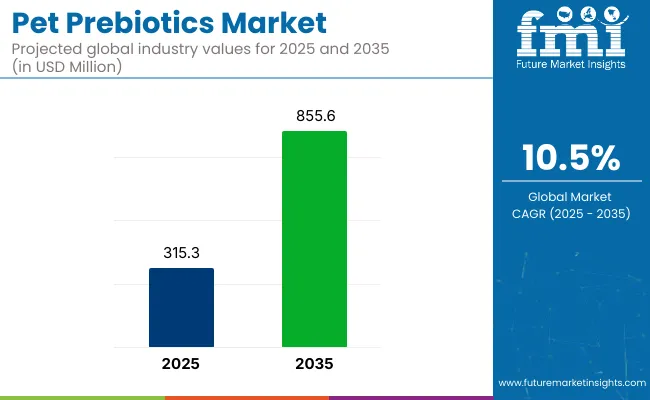
Metric Value Table
| Attributes | Description |
|---|---|
| Estimated Size (2025) | USD 315.3 million |
| Projected Value (2035) | USD 855.6 million |
| CAGR (2025 to 2035) | 10.5% |
Enhanced affordability, coupled with availability across a variety of formats, such as chewables, powders, and liquids, is encouraging adoption across diverse pet-owner demographics.
The USA is expected to retain the highest market share, growing at a CAGR of 10.2% from 2025 to 2035. Japan is set to be the fastest-growing country, expanding at a CAGR of 11.3%, followed closely by Germany at 9.7%. Chewables will remain the dominant form type due to their pet-friendly taste and convenience, projected to account for 38% of the market value by 2035. The over-the-counter (OTC) availability segment will maintain strong momentum with 68% of the market share.
The market holds a niche yet growing share within its parent segments. It accounts for approximately 8-10% of the pet supplements market, given its rising relevance in digestive health. Within the broader animal nutrition market, it holds around 3-4%, while contributing nearly 2% to the pet food market. Its share in the functional food ingredients market and digestive health ingredients market is under 1%, due to its pet-specific nature. As awareness of gut health increases, the pet prebiotics segment is expected to capture a larger portion, especially within pet supplements and companion animal health categories.
The global market is segmented into pet type, form, availability, sales channel, nature, application, and region. By pet type, it includes dog and cat. By form, it is segmented into pills/tablets, chewables, powder, liquid/syrup, paste/gel, and others (includes sprinkles, wafers, & soft chews). By availability, it is divided into prescription-based and over-the-counter.
By sales channel, it is segmented into store-based retailing (hypermarkets/supermarkets, convenience stores, pet stores, discounters, independent grocery retailers, drugstores) and online retailers (company website, e-commerce platform, hyperlocal delivery).
By nature, it includes organic and conventional. By application, it is segmented into gastrointestinal health, immune system support, skin & coat health, stress & anxiety reduction, weight management, allergy management, dental health, and joint health. By region, it covers North America, Latin America, Western Europe, Eastern Europe, Balkans & Baltic, Russia & Belarus, Central Asia, East Asia, South Asia & Pacific, Middle East and Africa.
Dogs are expected to remain the most lucrative pet type in the global prebiotics market, driven by higher supplement adoption rates among dog owners. Digestive issues, immune health concerns, and proactive wellness routines are more commonly addressed in dogs, particularly in North America and Europe. By 2035, the dog segment is anticipated to hold over 63% of the total market share, bolstered by increased awareness and higher average spending per pet.
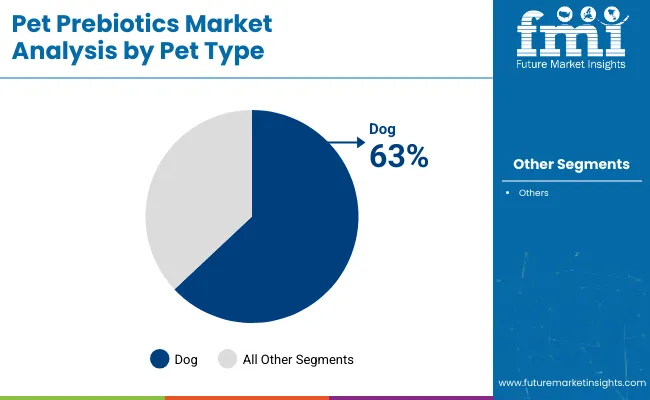
Chewables are expected to maintain dominance in the form segment as they offer the highest convenience and compliance. Pets typically prefer tasty, treat-like formats, and owners find them easier to administer daily. By 2035, chewables are forecast to account for 38% of the market, outpacing other forms like powders and syrups due to their ease of use and formulation versatility.
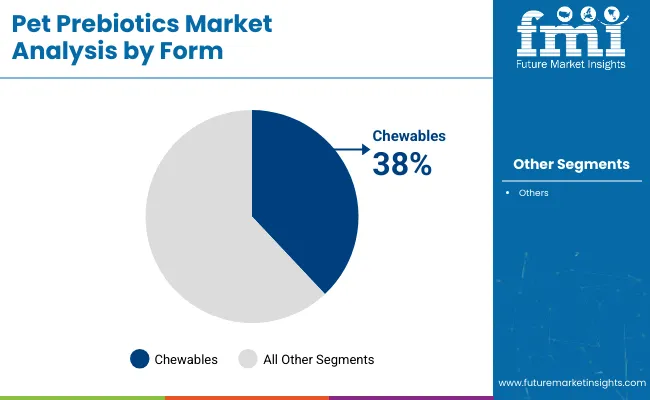
Over-the-counter availability has significantly widened market access, enabling direct purchases from retail and online platforms without veterinary consultations. This channel is projected to capture 68% of total sales by 2035. Rising consumer autonomy in pet healthcare and digital retail expansion have made OTC formats more appealing for routine supplementation.
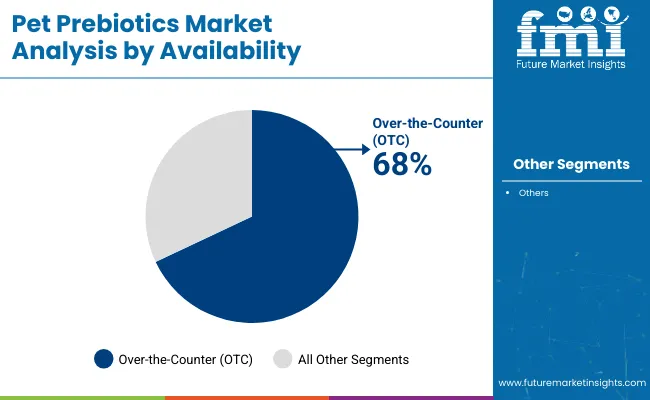
Online retailing is witnessing exponential growth, fueled by e-commerce platforms and hyperlocal delivery services. With pet owners seeking convenience and product comparisons, digital channels are expected to outperform physical stores. By 2035, e-commerce is estimated to contribute over 45% of total sales.
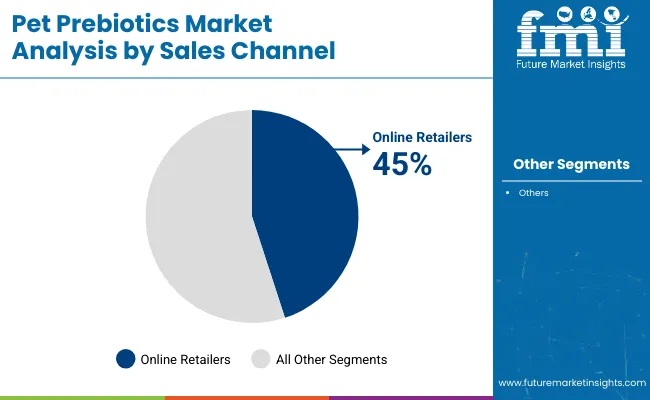
While conventional prebiotics still dominate, organic variants are growing rapidly in response to consumer demand for clean-label and ethically sourced products. By 2035, organic prebiotics are expected to account for nearly 28% of the total market. Their appeal lies in the absence of additives and synthetic carriers.
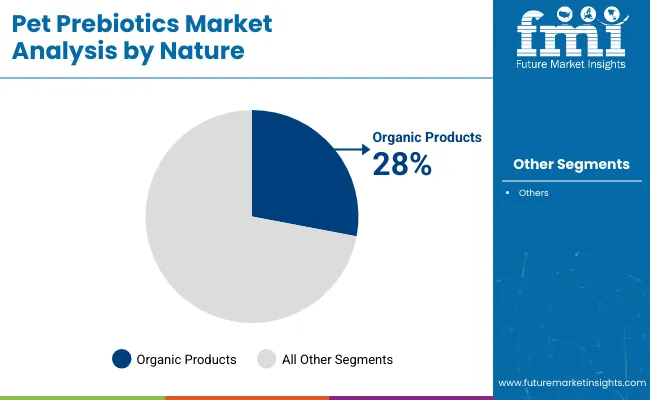
Gastrointestinal health will continue to be the most common application of pet prebiotics, representing approximately 33% of total demand by 2035. With rising cases of digestive issues in pets and growing scientific validation of prebiotics’ efficacy, this segment is expected to experience significant growth.
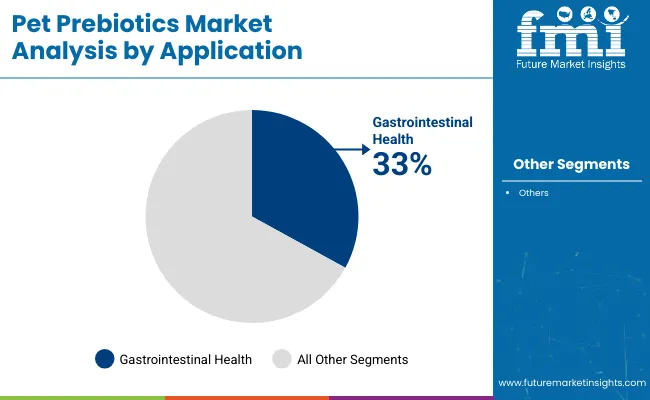
Recent Trends in the Pet Prebiotics Market
Key Challenges Restraining Pet Prebiotics Market Growth
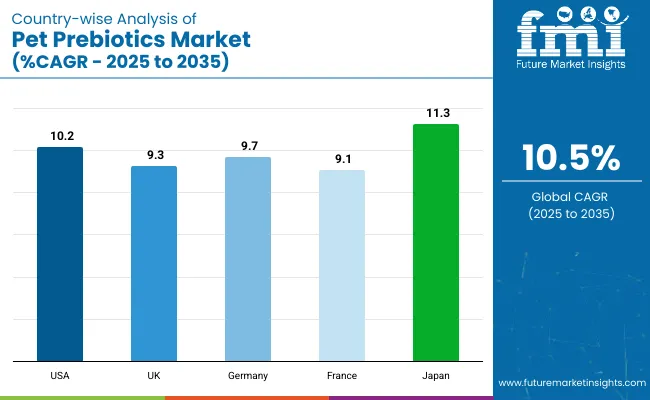
In the pet prebiotics market, Japan leads with the highest forecasted CAGR of 11.3% from 2025 to 2035, driven by the aging pet population and demand for premium, functional supplements. The USA follows closely with a 10.2% CAGR, backed by robust e-commerce and high consumer spending.
Germany is projected to grow at 9.7%, reflecting strong regulatory standards and clinical preference. The UK is anticipated to see growth at a 9.3% CAGR, shaped by demand for natural, cruelty-free products. France trails slightly at 9.1%, fueled by rising interest in plant-based and allergen-free supplements. All countries reflect strong trends toward wellness and preventive pet care.
The report covers an in-depth analysis of 40+ countries; five top-performing OECD countries are highlighted below.
The pet prebiotics revenue in the USA is projected to grow at a CAGR of 10.2% from 2025 to 2035, maintaining its position as the global leader with a forecasted 31.2% market share. This dominance is fueled by strong pet ownership rates, well-established veterinary infrastructure, and premiumization of pet wellness products.
In the UK, the pet prebiotics market is anticipated to expand at a CAGR of 9.3% through 2035, driven by a nationwide shift toward natural and additive-free pet supplements. British consumers are increasingly focusing on preventive care and overall wellness for pets.
The sales of pet prebiotics in Germany are forecasted to flourish at a CAGR of 9.7% from 2025 to 2035, supported by robust veterinary regulation and increasing pet adoption across urban households. German consumers are highly informed and prefer prebiotics with clinically backed efficacy.
The revenue from pet prebiotics in France is projected to rise at a CAGR of 9.1% between 2025 and 2035 in the pet prebiotics landscape. The country is witnessing a surge in demand for plant-based, allergen-free prebiotics as part of broader wellness trends in both human and animal nutrition.
The pet prebiotics market in Japan is expected to exhibit the fastest growth at a CAGR of 11.3% from 2025 to 2035 in the global pet prebiotics market. The country’s aging pet population and rising incidence of chronic digestive issues have amplified interest in gut-focused supplements.
The market is moderately consolidated, with a few global leaders accounting for a significant share of revenues. Tier-one companies like Alltech, DSM Nutritional Products AG, Vetanco, Nestlé Purina PetCare, Mars Petcare, Hill’s Pet Nutrition, Blue Buffalo, Royal Canin, Chr. Hansen and Beneo are competing based on innovation, strategic partnerships, and expansion into emerging markets. These companies focus on enhancing product efficacy, expanding distribution channels, and investing in research and development to meet the growing demand for pet health supplements.
Recent Pet Prebiotics Industry News
| Report Attributes | Details |
|---|---|
| Current Total Market Size (2025) | USD 315.3 million |
| Projected Market Size (2035) | USD 855.6 million |
| CAGR (2025 to 2035) | 10.5% |
| Base Year for Estimation | 2024 |
| Historical Period | 2020-2023 |
| Projections Period | 2025-2035 |
| Market Analysis Parameters | Revenue in USD millions/Volume in units |
| By Pet Type | Dog, Cat |
| By Form | Pills/Tablets, Chewables, Powder, Liquid/Syrup, Paste/Gel, Others |
| By Availability | Prescription-based, Over-the-counter (OTC) |
| By Sales Channel | Store-based Retailing, Online Retailers |
| By Nature | Organic, Conventional |
| By Application | Gastrointestinal Health, Immune System Support, Skin & Coat Health, Stress & Anxiety Reduction, Weight Management, Allergy Management, Dental Health, Joint Health |
| Regions Covered | North America, Latin America, Western Europe, Eastern Europe, East Asia, South Asia & Pacific, Middle East & Africa |
| Countries Covered | United States, Canada, United Kingdom, Germany, France, China, Japan, South Korea, Brazil, Australia |
| Key Players | Alltech, Inc., DSM Nutritional Products AG, Vetanco, Nestlé Purina PetCare, Mars Petcare, Hill’s Pet Nutrition, Blue Buffalo, Royal Canin, Chr. Hansen, Beneo |
| Additional Attributes | Dollar sales by value, market share analysis by region, and country-wise analysis |
As per Pet Type, the industry has been categorized into Dog & Cat.
As per Form, the industry has been categorized into Pills / Tablets, Chewables, Powder, Liquid / Syrup, Paste / Gel and Others.
As per Availability, the industry has been categorized into Prescription-based and Over-the-counter (OTC).
As per Sales Channel, the industry has been categorized into Store-based Retailing (Hypermarkets/Supermarkets, Convenience Stores, Pet Stores, Discounters, Independent Grocery Retailers, Drugstores) and Online Retailers (Company Website, E-commerce Platform, Hyperlocal Delivery).
As per Nature, the industry has been categorized into Organic and Conventional.
As per Application, the industry has been categorized into Gastrointestinal Health, Immune System Support, Skin & Coat Health, Stress & Anxiety Reduction, Weight Management, Allergy Management, Dental Health and Joint Health.
Industry analysis has been carried out in key countries of North America, Latin America, Western Europe Eastern Europe, Balkans & Baltic, Russia & Belarus, Central Asia, East Asia, South Asia & Pacific, and Middle East & Africa.
The market is valued at USD 315.3 million in 2025.
The market is forecasted to reach USD 855.6 million by 2035, reflecting a CAGR of 10.5%.
Chewables are expected to lead the market with a 38% share in 2025.
Over-the-counter (OTC) products are expected to hold a 68% market share by 2035.
Japan is anticipated to be the fastest-growing market with a CAGR of 11.3% from 2025 to 2035.






Our Research Products

The "Full Research Suite" delivers actionable market intel, deep dives on markets or technologies, so clients act faster, cut risk, and unlock growth.

The Leaderboard benchmarks and ranks top vendors, classifying them as Established Leaders, Leading Challengers, or Disruptors & Challengers.

Locates where complements amplify value and substitutes erode it, forecasting net impact by horizon

We deliver granular, decision-grade intel: market sizing, 5-year forecasts, pricing, adoption, usage, revenue, and operational KPIs—plus competitor tracking, regulation, and value chains—across 60 countries broadly.

Spot the shifts before they hit your P&L. We track inflection points, adoption curves, pricing moves, and ecosystem plays to show where demand is heading, why it is changing, and what to do next across high-growth markets and disruptive tech

Real-time reads of user behavior. We track shifting priorities, perceptions of today’s and next-gen services, and provider experience, then pace how fast tech moves from trial to adoption, blending buyer, consumer, and channel inputs with social signals (#WhySwitch, #UX).

Partner with our analyst team to build a custom report designed around your business priorities. From analysing market trends to assessing competitors or crafting bespoke datasets, we tailor insights to your needs.
Supplier Intelligence
Discovery & Profiling
Capacity & Footprint
Performance & Risk
Compliance & Governance
Commercial Readiness
Who Supplies Whom
Scorecards & Shortlists
Playbooks & Docs
Category Intelligence
Definition & Scope
Demand & Use Cases
Cost Drivers
Market Structure
Supply Chain Map
Trade & Policy
Operating Norms
Deliverables
Buyer Intelligence
Account Basics
Spend & Scope
Procurement Model
Vendor Requirements
Terms & Policies
Entry Strategy
Pain Points & Triggers
Outputs
Pricing Analysis
Benchmarks
Trends
Should-Cost
Indexation
Landed Cost
Commercial Terms
Deliverables
Brand Analysis
Positioning & Value Prop
Share & Presence
Customer Evidence
Go-to-Market
Digital & Reputation
Compliance & Trust
KPIs & Gaps
Outputs
Full Research Suite comprises of:
Market outlook & trends analysis
Interviews & case studies
Strategic recommendations
Vendor profiles & capabilities analysis
5-year forecasts
8 regions and 60+ country-level data splits
Market segment data splits
12 months of continuous data updates
DELIVERED AS:
PDF EXCEL ONLINE
Pet Food Pulverizer Market Size and Share Forecast Outlook 2025 to 2035
Pet Food Emulsifier Market Size and Share Forecast Outlook 2025 to 2035
PET Film for Face Shield Market Size and Share Forecast Outlook 2025 to 2035
Pet Perfume Market Size and Share Forecast Outlook 2025 to 2035
Pet Shampoo Market Size and Share Forecast Outlook 2025 to 2035
Pet Tick and Flea Prevention Market Forecast and Outlook 2025 to 2035
Pet Hotel Market Forecast and Outlook 2025 to 2035
PET Vascular Prosthesis Market Size and Share Forecast Outlook 2025 to 2035
Pet Food Preservative Market Forecast and Outlook 2025 to 2035
Petroleum Liquid Feedstock Market Size and Share Forecast Outlook 2025 to 2035
Pet Food Ingredients Market Size and Share Forecast Outlook 2025 to 2035
PET Stretch Blow Molding Machines Market Size and Share Forecast Outlook 2025 to 2035
PET Injectors Market Size and Share Forecast Outlook 2025 to 2035
PET Material Packaging Market Size and Share Forecast Outlook 2025 to 2035
Petri Dishes Market Size and Share Forecast Outlook 2025 to 2035
Petroleum And Fuel Dyes and Markers Market Size and Share Forecast Outlook 2025 to 2035
Petrochemical Pumps Market Size and Share Forecast Outlook 2025 to 2035
PET Dome Lids Market Size and Share Forecast Outlook 2025 to 2035
Pet Dietary Supplement Market Size and Share Forecast Outlook 2025 to 2035
PET Imaging Workflow Market Analysis - Size, Share, and Forecast Outlook 2025 to 2035

Thank you!
You will receive an email from our Business Development Manager. Please be sure to check your SPAM/JUNK folder too.
Chat With
MaRIA